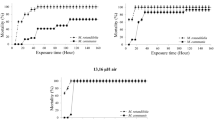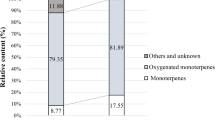Abstract
The aims of this work were to point out the seasonal variation in chemical composition and evaluate the insecticidal activities of Mentha spicata and Thymus vulgaris essential oils against larvae of three moths Ectomyelois ceratoniae, Ephestia kuehniella and Plodia interpunctella. GC–MS analyses indicated that major components of M. spicata essential oil were carvone, 1, 8-cineole and limonene. However, linalool, camphor and γ-terpinene were the main compounds for T. vulgaris. Results showed that chemical composition varied with plant species, as well as seasons. On the other hand, results indicated that mortality percentages were highest during the summer season at the concentration 16 µl/l air. Thus, fumigant toxicity depends on insect species, plants, seasons and concentrations. Besides, E. kuehniella was more sensitive to both oils as compared to E. ceratoniae and P. interpunctella. The LC50 values were 0.29, 4.40 and 2.51 µl/l air, respectively, for M. spicata. Concerning T. vulgaris, the respective LC50 values were 0.062, 4.61 and 3.23 µl/l air for E. kuehniella, E. ceratoniae and P. interpunctella. Furthermore, for the most toxic season, LT50 values of M. spicata were 0.7, 5.2 and 3.2 days, respectively, for E. kuehniella, E. ceratoniae and P. interpunctella. Regarding T. vulgaris, LT50 values were 0.35, 6.5 and 4.58 days, respectively, for E. kuehniella, E. ceratoniae and P. interpunctella. Therefore, essential oils collected during summer season could be considered as an effective tool of control against moths of stored products.

Similar content being viewed by others
References
Abbasipour H, Mahmoudvand M, Rastegar F, Hosseinpour MH (2011) Fumigant toxicity and oviposition deterrency of the essential oil from cardamom, Elettaria cardamomum, against three stored–product insects. J Insect Sci 11(165):1–10
Abbott WS (1925) A method of computing the effectiveness of an insecticide. J Econ Entomol 18(2):265–267
Abdelli W, Bahri F, Romane A, Höferl M, Wanner J, Schmidt E et al (2017) Chemical composition and anti-inflammatory activity of Algerian Thymus vulgaris essential oil. Nat Prod Commun 12(4):611–614
Ahmadi B, Moharramipour S, Sinclair BJ (2016) Overwintering biology of the carob moth Apomyelois ceratoniae (Lepidoptera: Pyralidae). Int J Pest Manag 62(1):69–74
Ainane A, Khammour F, M’hammed E, Talbi M, Oussaid A, Lemhidi A et al (2019) Evaluation of the toxicity of the essential oils of certain mints grown in the region of Settat (Morocco): Mentha piperita, Mentha pulegium and Mentha spicata against, Sitophilus Granarius, Sitophilus Oryzae and Sitophilus Zeamais. J Anal Sci Appl Biotechnol 1(1):2021–2010
Azelmat K, El Garrouj D, Mouhib M, Sayah F (2006) Irradiation of ‘Boufeggous’ dates: effects on chemical composition during storage. Postharvest Biol Technol 39(2):217–222
Batish DR, Singh HP, Kohli RK, Kaur S (2008) Eucalyptus essential oil as a natural pesticide. For Ecol Manag 256(12):2166–2174
Boulanouar A, Hamid K, Ahmed M, Larbi B, Saliha R, Siham B et al (2017) Variability of the physicochemical composition between unscathed and dates infested by the moth Ectomyelois ceratoniae Zeller. Appl Biol Sahar Areas 1(1):1–7
Bouzeraa H, Bessila-Bouzeraa M, Labed N, Sedira F, Ramdani L (2018) Evaluation of the insecticidal activity of Artemisia herba alba essential oil against Plodia interpunctella and Ephestia kuehniella (Lepidoptera, Pyralidae). J Entomol Zool Stud 6(5):145–150
Brahmi F, Adjaoud A, Marongiu B, Falconieri D, Yalaoui-Guellal D, Madani K et al (2016) Chemical and biological profiles of essential oils from Mentha spicata L. leaf from Bejaia in Algeria. J Essent Oil Res 28(3):211–220
Burks CS, Yasin M, El-Shafie HA, Wakil W (2015) Pests of stored dates. Sustainable pest management in date palm: current status and emerging challenges. Springer, New York, pp 237–286
Chauhan SS, Agarwal R (2013) Evaluation of antibacterial activity of volatile oil from Mentha spicata L. J Drug Deliv Ther 3(4):120–121
Clemente S, Mareggiani G, Broussalis A, Martino V, Ferraro G (2003) Insecticidal effects of Lamiaceae species against stored products insects. Bol De Sanid Veg Plagas 29(6):421–426
Ebadollahi A (2013) Essential oils isolated from Myrtaceae family as natural insecticides. Annu Res Rev Biol 3(3):148–175
Ebadollahi A, Ziaee M, Palla F (2020) Essential oils extracted from different species of the Lamiaceae plant family as prospective bioagents against several detrimental pests. Molecules 25(7):1556
Eliopoulos P, Hassiotis C, Andreadis S, Porichi A-E (2015) Fumigant toxicity of essential oils from basil and spearmint against two major pyralid pests of stored products. J Econ Entomol 108(2):805–810
EL-Sayed KK, EL-Sheikh E-SA, Sherif RM, Gouhar KA (2020) Comparative insecticidal activity of Anethum graveolens, Thymus vulgaris and Myristica fragrans essential oils against Tribolium castaneum and Oryzaephilus surinamensis. Ann Agri Bio Res 25(2):263–269
Fahlén A, Welander M, Wennersten R (1997) Effects of light–temperature regimes on plant growth and essential oil yield of selected aromatic plants. J Sci Food Agric 73(1):111–119
Finney DJ (1971) Probit analysis: a statistical treatment of the sigmoid response curve, 3rd edn. Cambridge University Press, Cambridge, p 333p
Gautam N, Mantha AK, Mittal S (2014) Essential oils and their constituents as anticancer agents: a mechanistic view. Biomed Res Int 2014(23):1–23
Ghouar M, Sabeg K, Boudjouref M (2018) Etude des activités biologiques de la plante. http://hdl.handle.net/123456789/5560.
Haouel S, Mediouni-Ben Jemâa J, Khouja ML (2010) Postharvest control of the date moth Ectomyelois ceratoniae using Eucalyptus essential oil fumigation. Tunis J Plant Prot 5(2):201–212
Idder-Ighili H, Idder MA, Doumandji-Mitiche B, Chenchouni H (2015) Modeling the effects of climate on date palm scale (Parlatoria blanchardi) population dynamics during different phenological stages of life history under hot arid conditions. Int J Biometeorol 59(10):1425–1436
Jemâa JMB, Haouel S, Bouaziz M, Khouja ML (2012) Seasonal variations in chemical composition and fumigant activity of five Eucalyptus essential oils against three moth pests of stored dates in Tunisia. J Stored Prod Res 48(8):61–67
Jemâa JMB, Haouel S, Khouja ML (2013) Efficacy of Eucalyptus essential oils fumigant control against Ectomyelois ceratoniae (Lepidoptera: Pyralidae) under various space occupation conditions. J Stored Prod Res 53(8):67–71
Jensen OM, Hansen PF (2002) Water-entrained cement-based materials: II. Experimental observations. Cem Concr Res 32(6):973–978
Jesser EN, Werdin-González JO, Murray AP, Ferrero AA (2017) Efficacy of essential oils to control the Indian meal moth, Plodia interpunctella (Hübner) (Lepidoptera: Pyralidae). J Asia-Pac Entomol 20(4):1122–1129
Kamatou GP, Van Zyl R, Van Vuuren S, Figueiredo A, Barroso J, Pedro L et al (2008) Seasonal variation in essential oil composition, oil toxicity and the biological activity of solvent extracts of three South African Salvia species. S Afr J Bot 74(2):230–237
Karabörklü S, Ayvaz A, Yilmaz S, Akbulut M (2011) Chemical composition and fumigant toxicity of some essential oils against Ephestia kuehniella. J Econ Entomol 104(4):1212–1219
Kostyukovsky M, Rafaeli A, Gileadi C, Demchenko N, Shaaya E (2002) Activation of octopaminergic receptors by essential oil constituents isolated from aromatic plants: possible mode of action against insect pests. Pest Manag Sci Former Pestic Sci 58(11):1101–1106
Lazarević J, Jevremović S, Kostić I, Kostić M, Vuleta A, Manitašević Jovanović S et al (2020) Toxic, oviposition deterrent and oxidative stress effects of Thymus vulgaris essential oil against Acanthoscelides obtectus. Insects 11(9):563–582
Madrid F, Sinha R (1982) Feeding damage of three stored-product moths (Lepidoptera: Pyralidae) on wheat. J Econ Entomol 75(6):1017–1020
Mancini E, Senatore F, Del Monte D, De Martino L, Grulova D, Scognamiglio M et al (2015) Studies on chemical composition, antimicrobial and antioxidant activities of five Thymus vulgaris L. essential oils. Molecules 20(7):12016–12028
Mediouni J, Dhouibi M (2007) Mass-rearing and field performance of irradiated carob moth Ectomyelois ceratoniae in Tunisia. Area-wide control of insect pests. Springer, New York, pp 265–273
Moazeni N, Khajeali J, Izadi H, Mahdian K (2014) Chemical composition and bioactivity of Thymus daenensis Celak (Lamiaceae) essential oil against two lepidopteran stored-product insects. J Essent Oil Res 26(2):118–124
Mokkadem A (1999) Cause de dégradation des plantes médicinales et aromatiques d’Algérie. Rev Vie Et Nat 7:24–26
Na JH, Ryoo MI (2000) The influence of temperature on development of Plodia interpunctella (Lepidoptera: Pyralidae) on dried vegetable commodities. J Stored Prod Res 36(2):125–129
Passino GS, Bazzoni E, Moretti M (2004) Microencapsulated essential oils active against indianmeal moth. Bol San Veg Plagas 30(8):125–132
Perez-Mendoza J, Aguilera-Pena M (2004) Development, reproduction, and control of the Indian meal moth, Plodia interpunctella (Hübner)(Lepidoptera: Pyralidae), in stored seed garlic in Mexico. J Stored Prod Res 40(4):409–421
Rees D (2004) Insects of stored products. CSIRO publishing, Clayton
Schöller M, Prozell S (2014) Stored-product insects and their natural enemies in Germany: a species-inventory. Integr Prot Stored Prod IOBC-WPRS Bull 98:27–34
Singh P, Pandey AK (2018) Prospective of essential oils of the genus Mentha as biopesticides: a review. Front Plant Sci 9(14):1–14
Song J, Lee SG, Lee H-S (2017) Insecticidal activities of Eucalyptus dives and Thymus vulgaris oils against Plodia interpunctella and Tribolium castaneum in the granary. J Appl Biol Chem 60(1):69–71
Souza VND, Oliveira CRFD, Matos CHC, Almeida DKFD (2016) Fumigation toxicity of essential oils against Rhyzopertha dominica (f.) in stored maize grain. Rev Caatinga 29(2):435–440
Subramanyam B, Hagstrum D, Schenk T (1993) Sampling adult beetles (Coleoptera) associated with stored grain: comparing detection and mean trap catch efficiency of two types of probe traps. Environ Entomol 22(1):33–42
Van Rooyen A (2017) An ecological analysis of stink bug and lepidopteran borer complexes associated with pecan and citrus orchards in the Vaalharts region. University of the Free State
Zerrifi SEA, Kasrati A, Tazart Z, El Khalloufi F, Abbad A, Oudra B et al (2020) Essential oils from Moroccan plants as promising ecofriendly tools to control toxic cyanobacteria blooms. Ind Crops Prod 143(8):11–19
Author information
Authors and Affiliations
Corresponding author
Additional information
Publisher's Note
Springer Nature remains neutral with regard to jurisdictional claims in published maps and institutional affiliations.
Rights and permissions
About this article
Cite this article
Aissaoui, F., Hedjal-Chebheb, M., Soltani, A. et al. Variations of chemical composition of two Algerian essential oils collected for different seasons and assessment of their insecticidal toxicity against three moth pests. J Plant Dis Prot 128, 1167–1176 (2021). https://doi.org/10.1007/s41348-021-00491-6
Received:
Accepted:
Published:
Issue Date:
DOI: https://doi.org/10.1007/s41348-021-00491-6




